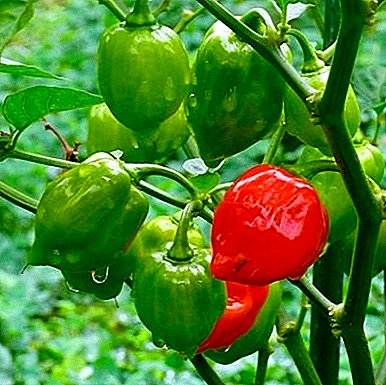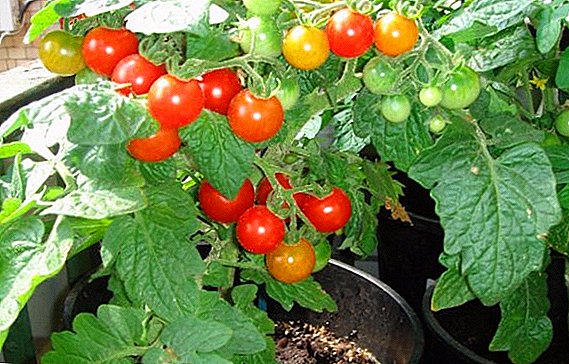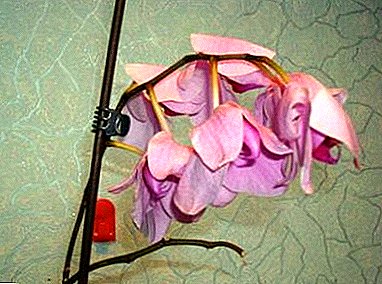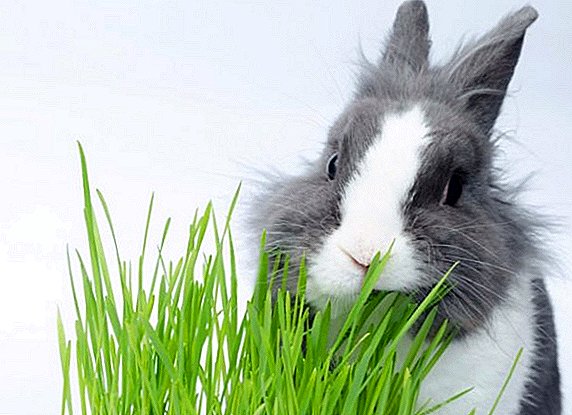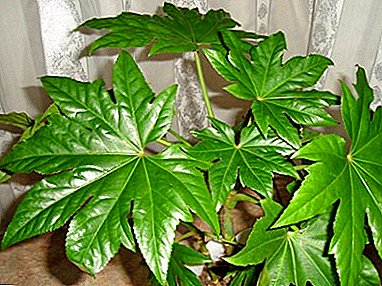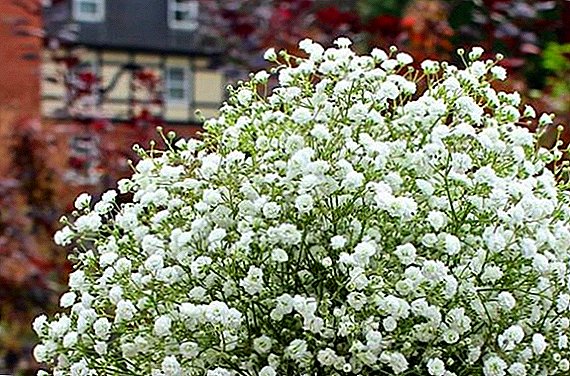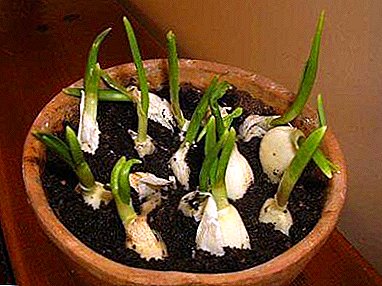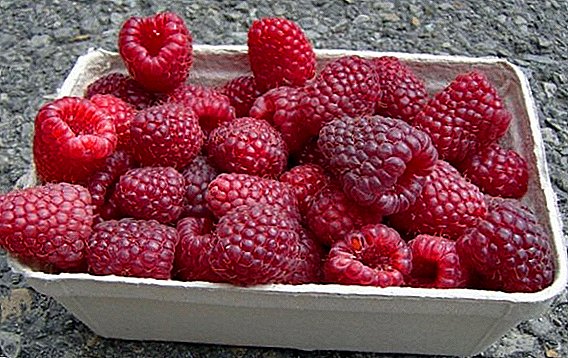 It is difficult to find a summer resident, in the area of which a tasty and fragrant raspberry would not grow. Together with currants, strawberries and other useful plants, it takes pride of place in almost any garden. Today, there are more than 120 different varieties of plants, but most people are only interested in large-shrubs with large and bright berries. These include the Polka raspberry variety (or "Shelf"), which will be discussed later.
It is difficult to find a summer resident, in the area of which a tasty and fragrant raspberry would not grow. Together with currants, strawberries and other useful plants, it takes pride of place in almost any garden. Today, there are more than 120 different varieties of plants, but most people are only interested in large-shrubs with large and bright berries. These include the Polka raspberry variety (or "Shelf"), which will be discussed later.
Breeding history
The raspberry variety was bred in 1993 by Polish breeder Jan Danek who works at the Brzezno Horticultural Research Station. All that needed to be done to obtain a plant was to pollinate an “Autumn Bliss” variety with experimental samples of P89141. Nowadays raspberry "Polka" is one of the most cultivated remontant varieties in industrial gardening.
Remontant is not only raspberries, but also blackberries, strawberries and strawberries.
Description and characteristics of the variety
"Polka" refers to medium-growth raspberry varieties (the bush grows up to 1.5-1.8 m), the fruiting of which begins from the end of July and lasts until the first frost. It has a high yield (on average it is up to 4 kg from 1 bush) and the ability to ripen berries at temperatures from 0 ° C to -2 ° C.  In addition, you can collect them twice a year, because in addition to the main crop, last year's shoots give fruit in early summer. Berries of the specified grade - large, bright red and extended to a bottom, on the sun give characteristic shine. On average, one berry weighs 5-7 g. It has dense and juicy flesh, small drupe. The taste of the fruit is sweet, but with a slight acidity and a very rich aroma. They are waiting in the wings on brushes formed by 6-10 berries.
In addition, you can collect them twice a year, because in addition to the main crop, last year's shoots give fruit in early summer. Berries of the specified grade - large, bright red and extended to a bottom, on the sun give characteristic shine. On average, one berry weighs 5-7 g. It has dense and juicy flesh, small drupe. The taste of the fruit is sweet, but with a slight acidity and a very rich aroma. They are waiting in the wings on brushes formed by 6-10 berries.
Shoots varieties have thorns, but they are all small, soft and do not cause any inconvenience. When growing raspberries for personal use, you can leave part of the shoots for the next year, which will ensure the said double harvest.
However, when growing plants on an industrial scale, such a decision is inappropriate, since it is a big burden on the bush. In this case, it is desirable to annually cut off the shoots (completely) and collect only the main crop. In this case, the ripening raspberries "Polki" will be profitable from a commercial point of view, of course, subject to proper care, in particular, and pruning. 
Features of growing raspberries
As with the cultivation of other “summer” plants, before planting “Polka” it is necessary to choose the right place and prepare a substrate in which the selected seedlings can grow and develop as efficiently as possible.. Now about everything in order.
Landing place
An ideal place for planting the described variety is a well-lit area with no overgrowth of other plants and it is well blown by the wind. Nevertheless, try not to place the raspberries in a strong sun, otherwise the berries will get serious burns. The most vulnerable are the first fruits that appear, as they are not covered by leaves.while later ones will already have their own protection in the form of sheet plates. 
Optimum soil
"Polka" prefers neutral or slightly acidic soil, although in general it is unpretentious and can grow on almost any soil. The fact is that for her the composition of the land is not so important as the subsequent feeding in the form of a planting bed of humus (1 bucket) and azofoski (4 tablespoons) pledged to the bottom.
If you are going to plant your raspberry in autumn, then the soil should be prepared for 1.5-2 months, spreading evenly on the site a mixture consisting of 70 g of superphosphate, 20 kg of manure and 50 g of potassium sulfate (per 1 m²).  Before spring planting, planting pits (40 cm in diameter and 50 cm deep) should be dug out in two weeks, laying in them the top layer of soil mixed with fertilizer (take the same proportions as for the autumn planting).
Before spring planting, planting pits (40 cm in diameter and 50 cm deep) should be dug out in two weeks, laying in them the top layer of soil mixed with fertilizer (take the same proportions as for the autumn planting).
Important! If the selected site is predominantly heavy soils, then sanding of the soil is carried out, based on four buckets of sand per 1 m² of territory.
Selection of seedlings and planting "Polka"
After reviewing the peculiarities of the Polka raspberry, if you are satisfied with the general description of this variety and its yield from a single shrub, it's time to move on to purchase seedlings. Of course, to obtain a good planting material such purchases are permissible only in specialized stores or special garden nurseries. Even if you find a trusted supplier, you need to know what to look for when buying it.
First of all, estimate the size of the bush and the number of shoots on it, since small seedlings are more viable, even if they are only 2-3 shoots of average thickness. Do not forget to pay attention to the roots of the seedling: they must be well developed and thick, without damaged or dried parts. Do not pay attention to the specimens with woody growths and flakings, since these features are the first signs of cancer.  At the base of the shoot of the selected seedling there should be at least three buds, from which the fruit bearing branches develop. In addition, a good planting material surface shoots absolutely clean, without spots, cracks and black dots.
At the base of the shoot of the selected seedling there should be at least three buds, from which the fruit bearing branches develop. In addition, a good planting material surface shoots absolutely clean, without spots, cracks and black dots.
If your chosen copy meets all the specified requirements - you can safely buy it and proceed to the landing.
First of all, always adhere to the raspberry planting scheme, especially if you are going to plant many bushes on the site. The optimal inter-row width is 1.5 m, with a distance of 0.5-1 m between adjacent plants. However, it should be taken into account that there will be gaps in the presence of attacks, and in this case the distance between them will be more significant - about two meters.
Familiarize yourself with the agrotechnics of growing other varieties of raspberry: "Caramel", "Gusar", "Hercules", "Yellow Giant", "Cumberland", "Atlant".
Suppose you have already dug pits and brought complex organic fertilizers to their bottom (for example, “Agriprirost”); now you just have to put a seedling in it, gently straightening its roots and cover it with earth. But even here there are some nuances: it is necessary to lay the plant in a horizontal position so that the replacement bud is 3-5 cm below the soil level.  Once the soil has completely covered the roots of the plant, it is necessary to tamp it down with a foot, and then form a hole and pour a bucket of water into it, and after completely absorbing moisture, hammer the hole with straw, peat or fresh earth. The seedling itself at a height of 35-40 cm from the surface should be cut.
Once the soil has completely covered the roots of the plant, it is necessary to tamp it down with a foot, and then form a hole and pour a bucket of water into it, and after completely absorbing moisture, hammer the hole with straw, peat or fresh earth. The seedling itself at a height of 35-40 cm from the surface should be cut.
It is advisable to carry out planting of landing material in dry and calm weather, placing rows under the landing from the north to the southern part of the territory.
How to provide the right care?
From the moment of planting begins the period of active care of raspberries, which includes regular watering, fertilizing, pruning and other equally important agrotechnical measures. How to cope with this task - we will now tell.
Watering
In the Polka variety, the root system is located very close to the soil surface, therefore there is a risk of its rapid drying. To avoid this, the plant is regularly and abundantly watered, bringing 2-3 buckets of water under one bush. The soil should get wet 30-40 cm deep, therefore, to achieve a similar result, it is best to use a drip system for watering.  The main watering of the shrub falls on the period of its flowering, and the last time the liquid under the bushes is made soon after harvesting. The frequency and intensity of irrigation can be adjusted depending on weather conditions. On especially hot days, raspberries must be shaded, because even with drip irrigation, the berries will “roast” in the sun.
The main watering of the shrub falls on the period of its flowering, and the last time the liquid under the bushes is made soon after harvesting. The frequency and intensity of irrigation can be adjusted depending on weather conditions. On especially hot days, raspberries must be shaded, because even with drip irrigation, the berries will “roast” in the sun.
Top dressing
With the arrival of the first warm spring days, the active growth of "Polka" begins, which means that the first feeding should be in April. Potash and phosphate compounds (for example, the aforementioned azophoska) are used to fertilize plants during this period, in a ratio of 100 g per 1 m².
Since the beginning of summer, organic dressings are carried out three times. (in a month), using ammonium nitrate (30 g), superphosphate (60 g) and potassium salt (40 g) diluted in 1 l of pure water for foliar fertilizers. For root feeding you need 3 kg of humus, 4 g of phosphorus and 6 g of nitrogen and potassium each. All components are mixed and scattered on the site in the proportion of 1.5 kg per 1 m².  Very important for the "Polka" is an autumn dressing, performed 1 time in 3 years (on very depleted soils - annually). It provides for the scattering of sheep, horse or cow manure in a plot of 5 kg of organic matter per 1 m² of territory. This dressing usually occurs at the beginning of September; it is this that influences the formation of the future raspberry crop. In parallel, growth processes are slowed down and the culture slowly prepares for winter rest.
Very important for the "Polka" is an autumn dressing, performed 1 time in 3 years (on very depleted soils - annually). It provides for the scattering of sheep, horse or cow manure in a plot of 5 kg of organic matter per 1 m² of territory. This dressing usually occurs at the beginning of September; it is this that influences the formation of the future raspberry crop. In parallel, growth processes are slowed down and the culture slowly prepares for winter rest.
Fertilizing plants is best done after watering, before loosening the soil.
Important! In the process of the last, autumn, top dressing be very careful with the proportions, otherwise you can burn both the plant itself and the soil in which it grows.
Soil care
Since the described variety needs well-ventilated soil, it will not work without loosening it. At the beginning of the year, this procedure is performed before the beginning of the growing season (the depth of loosening under the bushes is up to 7 cm, and between adjacent rows this value can reach 12 cm).  In some cases, loosening is best done up to 5 cm deep, since due to the proximity of the root system to the surface, there is a risk of damage. During the season, this procedure is repeated up to 5 times, during which it is disposed not only of the crust on the surface of the soil, but also of all the weeds that come to hand.
In some cases, loosening is best done up to 5 cm deep, since due to the proximity of the root system to the surface, there is a risk of damage. During the season, this procedure is repeated up to 5 times, during which it is disposed not only of the crust on the surface of the soil, but also of all the weeds that come to hand.
Moistened and loosened soil can be mulched sawdust, peat or compost, which are rotting, become an excellent source of nutrients. In winter, mulch will help to avoid freezing of the soil, and in the summer will not allow it to overheat. After wintering, peat or sawdust is mixed with the top layer of earth.
Garter
Unlike other middle-class varieties, the Polka raspberry does not need a garter so much, although in some cases its support with a trellis is simply necessary. With strong gusts of wind, strong enough shoots can not always survive, so poles 1.5-2 m long are installed in a row. Raspberry shoots are tied to a wire stretched between them at a height of 35 cm, 1 or 1.5 meters. Annual stalks are fixed to the trellis only for the winter. 
Pruning
Like all raspberry bushes, the Polka variety cannot do without pruning. But the method chosen in this case will depend on how many raspberry crops you want to harvest. The main thing to remember when forming is that 5-7 main shoots should be kept on the bush.
Yellow and black raspberries are not so common in home gardening, but they have a lot of advantages and are characterized by an interesting taste and color of berries.
When growing two yields, the plants must be cut in spring or already late autumn. (typical for the southern regions), removing the part of the shoot on which the fruit grew or the stems are damaged. The left part will be enough to form a summer harvest, while the young one-year-olds will be able to ripen the autumn one.  If the second gathering of berries is no good to you, then the pruning of the bushes is carried out in November, removing all the stems at ground level and not leaving hemp. There is no need to hurry with pruning, because before the soil is frozen, the culture continues to take from it useful and nutrients that will be useful to it for normal development next year. Fully cropped raspberries in the fall become more resistant to diseases, and its overall performance improves significantly. After removing all the stems from the bush, they must be removed from the raspberries and burned.
If the second gathering of berries is no good to you, then the pruning of the bushes is carried out in November, removing all the stems at ground level and not leaving hemp. There is no need to hurry with pruning, because before the soil is frozen, the culture continues to take from it useful and nutrients that will be useful to it for normal development next year. Fully cropped raspberries in the fall become more resistant to diseases, and its overall performance improves significantly. After removing all the stems from the bush, they must be removed from the raspberries and burned.
Important! With two raspberry harvests, they will not be as abundant as one, but this is enough for their own needs.Do not forget about the phenomenon of rationing, providing for the retention of the number of shoots at the level of 5-7 pieces. This will prevent excessive thickening of plantings, will contribute to a more harmonious development of plants.
Disease treatment
"Polka" is practically not susceptible to the most common "crimson" diseases and pests, for example, to rot (especially sulfur) or spider mite. Also, worms and other minor pests are not found on it, since the flowering and fruiting of bushes begin later than in the main part of remontant varieties.
The most vulnerable place of the variety is the root, and the most dangerous disease is cancer, manifested as growths on the root system. To prevent this disease, gypsum and physiologically acidic phosphate-potassium fertilizers are applied to the soil, but it is useless to treat cancer, because after 1-2 years the existing growths will still disintegrate, and the causative agent of the disease will get over to the soil, where 3 years.  With high acidity of the soil and a deficiency of potassium, the bush can react with reddening of the foliage, although the same peculiarity is characteristic with a lack of nutrition. Other possible diseases of "Polka" include chlorosis, white and purple spotting, anthracnose. For their treatment and prophylaxis, spraying with a 0.1% solution of Methylmercaptophos (carried out before flowering begins), a 1% Bordeaux mixture (before budding) and a 1% solution of colloidal sulfur (during bud formation and after picking berries) are used.
With high acidity of the soil and a deficiency of potassium, the bush can react with reddening of the foliage, although the same peculiarity is characteristic with a lack of nutrition. Other possible diseases of "Polka" include chlorosis, white and purple spotting, anthracnose. For their treatment and prophylaxis, spraying with a 0.1% solution of Methylmercaptophos (carried out before flowering begins), a 1% Bordeaux mixture (before budding) and a 1% solution of colloidal sulfur (during bud formation and after picking berries) are used.
In most cases, for the recovery of raspberry bushes enough to fertilize them before watering wood ashes.  If raspberry bushes still attacked a stem fly, raspberry beetle, weevil, aphid or kidney moth, then standard insecticides will help to fight against them: Karbofos, Iskra-M, Fufanon or Inta-Vir.
If raspberry bushes still attacked a stem fly, raspberry beetle, weevil, aphid or kidney moth, then standard insecticides will help to fight against them: Karbofos, Iskra-M, Fufanon or Inta-Vir.
Did you know? In addition to the red and black raspberries, there is also its purple variety. For the first time such a “miracle” was shown in 1893 in Geneva, and it was succeeded to get it by crossing these options. True, in North America and before that there were cases of the natural reproduction of such a plant, in those places where the red and black varieties grew on the same territory.
How to prepare the plant for winter
If the bush is not cut for the winter, which, as we said, is better to do, then it should be mulched using peat, basalt cotton wool, moss or coconut chips. It is extremely undesirable to use tyrs for this purpose, as it will pull moisture, creating an excellent environment for the development of bacteria and subsequent decay. For additional protection, fir spruce branches can be placed on top of the mulch layer, especially if a harsh winter is foreseen.
Leaving the bushes uncut, be sure to clean the leaves from their shoots, which can be done with the use of mittens, which is carried out along the stem from the bottom up. It is better not to move in the opposite direction, otherwise there is a risk of seriously damaging the kidneys. If the leaves remain in place, then under the influence of precipitation they will start to rot very quickly, which will have an extremely negative effect on the kidneys. Two growing nearby bush bend to each other at a level of 50 cm from the ground and fixed in this position.  However, it is better to completely cut off the "Polka", especially if you are not going to "stretch" the harvest for the next year. A plot with cut shoots is covered with a layer of sawdust or straw, 20 cm thick. In winter, the raspberry can be additionally covered with snow or special agrofibre.
However, it is better to completely cut off the "Polka", especially if you are not going to "stretch" the harvest for the next year. A plot with cut shoots is covered with a layer of sawdust or straw, 20 cm thick. In winter, the raspberry can be additionally covered with snow or special agrofibre.
Important! In no case can not water the raspberries, as in the winter this process will simply destroy it.If there are holes near the bushes, they are necessarily filled with soil, as otherwise water will collect, the stagnation of which can also damage the root system of the raspberry. In winter, the crust formed near the plants must be pierced, thereby providing air access to the roots.
Pros and cons varieties
When planting any plant on your plot, it is important to immediately determine all its advantages and disadvantages, because it is likely that there will be more of the latter and you will have to abandon this idea altogether. Nevertheless, this is not about the "Polka", because in this class just a lot of advantages. In particular, they include:
- the perfect appearance of the fruit, so that this raspberry is considered the best European dessert variety;
- high yields (there were cases when up to 12 tons of raspberries were collected from 1 ha);
- the duration of fruiting (good feeding will allow you to harvest twice a year, and without significant load on the bush itself);
- high resistance of the variety to pests and diseases;
- good transportability, keeping quality and dry separation of the berries, so that they look fresh even after freezing;
- the lack of serious thorns, which greatly facilitates the process of harvesting;
- плоды "Польки" отлично подходят для всевозможных консерваций как для классического варенья, так и для морсов или желе;
- рентабельность сорта благодаря выгодному периоду плодоношения.
Согласитесь, немаленький список плюсов, хотя нечестно будет не вспомнить и об определенных минусах, которых, к слову, намного меньше. Raspberry "Polka", with the description of the variety you just read, is not very frost resistant and does not tolerate summer temperature rises (up to + 35 ° С and higher), as a result of which the berries collected will not look so attractive in the photo (this is shown by numerous reviews of culture).  In addition, resistance to the most common diseases of the aerial part is overshadowed by an increased risk of root diseases: cancer, rot, etc. Do not forget about the need for abundant nourishment, since with a lack of potassium, nitrogen or organic matter, the rate of formation of new shoots will only worsen. Otherwise, the described variety is a good option for breeding on your plot, and it does not matter if you plant raspberries for personal use or for commercial purposes.
In addition, resistance to the most common diseases of the aerial part is overshadowed by an increased risk of root diseases: cancer, rot, etc. Do not forget about the need for abundant nourishment, since with a lack of potassium, nitrogen or organic matter, the rate of formation of new shoots will only worsen. Otherwise, the described variety is a good option for breeding on your plot, and it does not matter if you plant raspberries for personal use or for commercial purposes.
Did you know? Raspberry is an excellent antidepressant because it contains copper. Therefore, if you are depressed or on the verge of stress, try to eat a bowl of these fragrant berries.
Polka Breeding Rules
The variety "Polka" is propagated in two ways - through root shoots (more advantageous from a temporary point of view) and through the use of green cuttings harvested at the end of spring. In the first case, with the arrival of heat (although it is possible to perform the procedure in the fall), a part of a bush (10–20 cm in diameter) is dug out from the center of a two or three year old plant and moved to another place. The remaining roots in the soil for the season will again give up to 20 new offspring (appear gradually, during the vegetative period).  For breeding "Polka" by cutting the perfect annual shoots (about 3-5 cm). Such a stalk should be carefully cut and reach along with the earthy ball. Do not forget to treat the cut place with charcoal and place it in light and nutritious soil for better rooting. In open ground, the segment can be planted in about a month.
For breeding "Polka" by cutting the perfect annual shoots (about 3-5 cm). Such a stalk should be carefully cut and reach along with the earthy ball. Do not forget to treat the cut place with charcoal and place it in light and nutritious soil for better rooting. In open ground, the segment can be planted in about a month.
As you can see, there is nothing supernatural in the reproduction of the variety "Polka", as, indeed, in all cultivation of a culture, and very soon it will be possible to enjoy large, tasty raspberry berries.



